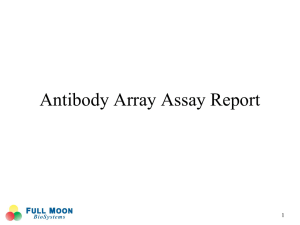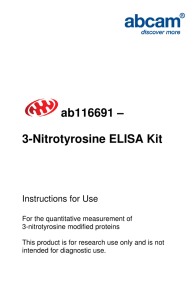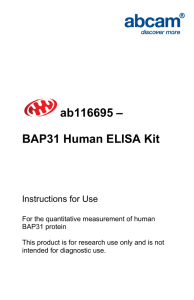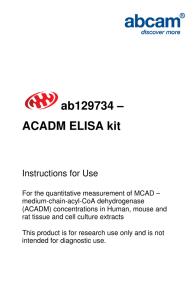ab124537 – Cyt C Reductase (Complex III) Human Profiling ELISA Kit
advertisement
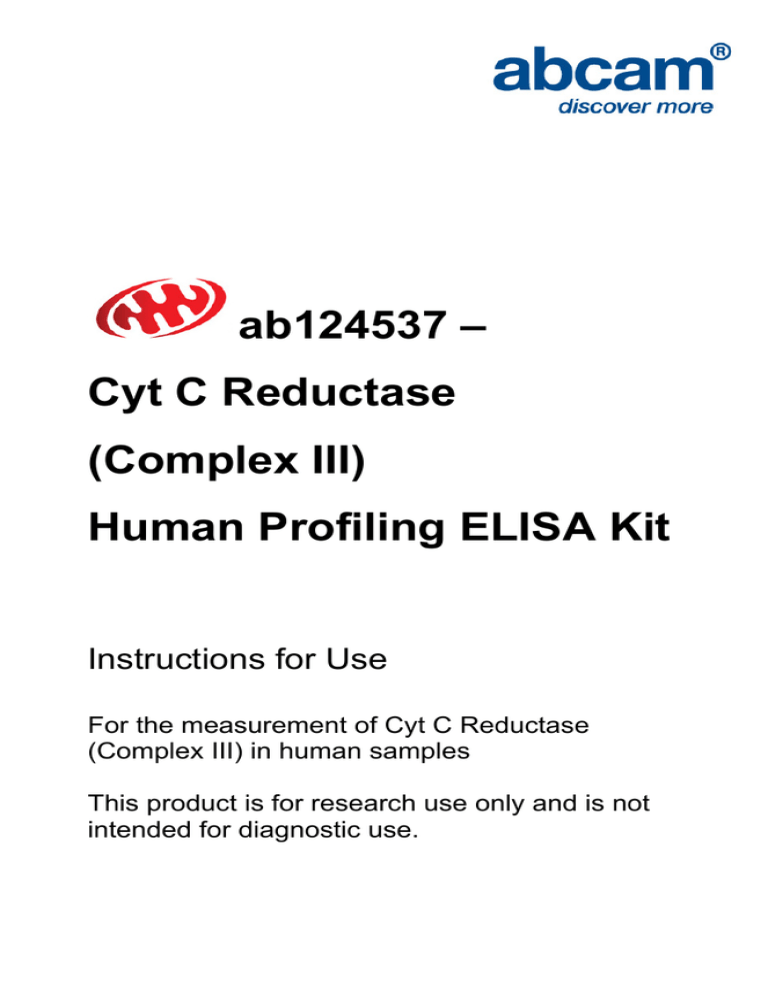
ab124537 – Cyt C Reductase (Complex III) Human Profiling ELISA Kit Instructions for Use For the measurement of Cyt C Reductase (Complex III) in human samples This product is for research use only and is not intended for diagnostic use. 1 Table of Contents 1. Introduction 3 2. Assay Summary 5 3. Kit Contents 6 4. Storage and Handling 6 5. Additional Materials Required 7 6. Preparation of Reagents 7 7. Sample Preparation 8 8. Control Sample Dilution Series Preparation 11 9. Assay Procedure 12 10. Data Analysis 15 11. Specificity 17 12. Troubleshooting 20 2 1. Introduction Principle: ab124537 Cyt C Reductase (Complex III) human profiling kit is an in vitro enzyme-linked immunosorbent assay (ELISA) for the comparison of Complex III levels or profile in cell and tissue lysates. The assay employs a human Complex III specific antibodycoated onto microplate well plate strips. Samples are pipetted into the wells and Complex III present in the sample is bound to the wells by the immobilized antibody. The wells are washed and an anti-Complex III detector antibody is added. After washing away unbound detector antibody, an HRP-conjugated secondary antibody specific for the detector antibody is pipetted into the wells. The wells are again washed, an HRP substrate solution (TMB) is added to the wells and color develops in proportion to the amount of Complex III bound. The developing blue color is measured at 600 nm. Optionally the reaction can be stopped by adding hydrochloric acid which changes the color from blue to yellow and the intensity can be measured at 450 nm. 3 Background: Cyt C Reductase (Complex III) is the third enzyme of the oxidative phosphorylation (OXPHOS) system within the mitochondrial inner membrane. Cyt C Reductase is a large protein complex of approximately 250,000 MW made up of 11 different subunits. The enzyme forms a dimer in the mitochondrial inner membrane. The catalytic subunit cytochrome b is encoded on mitochondrial DNA (mtDNA). All other subunits are encoded by nuclear genomic DNA, made in the cytosol, and translocated into the organelle for assembly at the inner membrane. Complex III catalyses the pumping of protons across the inner membrane and transfer of electrons from ubiquinol to cytochrome c by a mechanism known as the Q cycle in which ubiquinol (Q) the electron carrier exists as a reduced, partially reduced or oxidized form. Mutations in Complex III genes or assembly factors are a cause of genetic OXPHOS defects, though rare. It is believed that Complex III may be a major source of superoxides and reactive oxygen species contributing to multiple pathologies including neurodegenerative conditions and the free radical theory of aging itself. The partially reduced semi-quinone formed in the Q cycle may be the source of the electrons needed to make superoxide and the rate of electron leak may be increased during hypoxic conditions and in the presence of mitochondrial inhibitors. 4 2. Assay Summary Equilibrate all reagents to room temperature. Prepare all the reagents, and samples as instructed. Add 50 L sample to each well used. Incubate 2 hours at room temperature. Aspirate and wash each well two times. Add 50 L prepared detector antibody to each well. Incubate 1 hour at room temperature. Aspirate and wash each well two times. Add 50 L prepared HRP label. Incubate 1 hour at room temperature. Aspirate and wash each well three times. Add 100 L TMB Development Solution to each well. Immediately record the color development with elapsed time at 600 nm for 15 minutes. Alternatively add a Stop solution at a user-defined time and read at 450 nm. 5 3. Kit Contents Item Quantity 20X Buffer 20 mL Extraction Buffer 15 mL 10X Blocking Buffer 6 mL TMB Development Solution 12 mL 10X Complex III Detector Antibody 1 mL 10X HRP Label 1 mL Complex III Microplate 1 (12 x 8 antibody coated well strips) 4. Storage and Handling Store all components at 4°C. This kit is stable for 6 months from receipt. Unused microplate strips should be returned to the pouch containing the desiccant and resealed. 6 5. Additional Materials Required Microplate reader capable of measuring absorbance at 600 nm (or 450 nm after addition of Stop solution - not supplied). Method for determining protein concentration (BCA assay recommended). Deionized water Multi and single channel pipettes PBS (1.4 mM KH2PO4, 8 mM Na2HPO4, 140 mM NaCl, 2.7 mM KCl, pH 7.3) Tubes for standard dilution Stop solution (optional) – 1N hydrochloric acid Optional plate shaker for all incubation steps Plate cover or seals 6. Preparation of Reagents 6.1 Equilibrate all reagents to room temperature (18-25oC) before use. 6.2 Prepare 1X Wash Buffer by adding 20 mL 20X Buffer to 380 mL nanopure water. Mix gently and thoroughly. 7 6.3 Prepare 1X Incubation Buffer by adding 6 mL 10X Blocking Buffer to 54 mL 1X Wash Buffer. Unused 1X Incubation buffer may be stored at -20°C for 6 months after performing assay. Mix gently and thoroughly. 6.4 Prepare the 1X Complex III Detector Antibody by diluting the 10X Complex III Detector Antibody 10-fold with 1X Incubation Buffer immediately prior to use. Prepare 0.5 mL for each 8 well strip used. 6.5 Prepare the 1X HRP label by diluting the stock 10X HRP Label 10-fold with 1X Incubation Buffer immediately prior to use. Prepare 0.5 mL for each 8 well strip used. 7. Sample Preparation Note: Extraction buffer can be supplemented with phosphatase inhibitors, PMSF and protease inhibitor cocktail prior to use. Supplements should be used according to manufacturer’s instructions. 7.1. Cell lysates. 7.1.1 Collect non adherent cells by centrifugation or scrape to collect adherent cells from the culture flask. Typical centrifugation conditions for cells are 500 x g for 10 min at 4oC. 8 7.1.2 Rinse cells twice with PBS. 7.1.3 Solubilize cell pellet at 2x107/mL in Extraction Buffer. 7.1.4 Incubate on ice for 20 minutes. 16,000 x g for 20 minutes at 4°C. Centrifuge at Transfer the supernatants into clean tubes and discard the pellets. Assay samples immediately or aliquot and store at -80°C for 6 months. The sample protein concentration in the extract may be quantified using a protein assay. 7.2. Tissue lysates. 7.2.1 Tissue lysates are typically prepared by homogenization of tissue that is first minced and thoroughly rinsed in PBS to remove blood (dounce homogenizer recommended). 7.2.2 Suspend the homogenate to 25 mg/mL in PBS. 7.2.3 Solubilize the homogenate by adding 4 volumes of Extraction Buffer to a sample concentration of 5 mg/mL. 7.2.4 Incubate on ice for 20 minutes. Centrifuge at 16,000 x g, for 20 minutes at 4°C. Transfer the supernatants into clean tubes and discard the pellets. Assay samples immediately or aliquot and store at -80°C. The sample protein concentration in the extract may be quantified using a protein assay. 9 7.3. Sub-cellular organelle lysates e.g. mitochondria. 7.3.1 Prepare the organelle sample by, for example, subcellular fractionation. 7.3.2 Pellet the sample. 7.3.3 Solubilize the pellet by adding 9 volumes Extraction Buffer. 7.3.4 Incubate on ice for 20 minutes. 16,000 x g for 20 minutes at 4°C. Centrifuge at Transfer the supernatants into clean tubes and discard the pellets. Assay samples immediately or aliquot and store at -80°C. The sample protein concentration in the extract may be quantified using a protein assay. The sample should be diluted to within the working range of the assay in 1X Incubation Buffer. As a guide, typical ranges of sample concentration for commonly used sample types are shown below in Data Analysis. 10 8. Control Sample Dilution Series Preparation Note: It is strongly recommended to prepare a dilution series of control (normal) material. The relative levels or profile of Complex III in unknown samples can be interpolated from within this control sample series. 8.1. To create a dilution series of control sample, label a series of tubes #2-7. Add 150 L 1X Incubation buffer to each of tubes #2 through #7. 8.2. Prepare all samples by detergent extraction as described. Dilute the control sample lysate to 1 mg/mL in 1X Incubation buffer, label this tube #1. Undiluted control sample can be frozen at -80oC. 8.3. Transfer 150 L from tube #1 to tube #2. Mix thoroughly. With a fresh pipette tip transfer 150 L from #2 to #3. 8.4. Repeat serial dilution as in step 8.3 for Tubes #3 through #7. Use 1X Incubation buffer as the zero sample tube labeled #8. Use a fresh dilution series for each assay. 11 150 l Control sample 150 l 150 l 150 l 150 l 2 3 4 5 1/2 1/4 1/8 1/16 150 l 6 1/32 7 1/64 1 mg/mL in 1X Incubation buffer 9. Assay Procedure Bring all reagents and samples to room temperature before use. It is recommended all samples and standards be assayed in duplicate. 9.1. Prepare all reagents, control and unknown samples as directed in the previous sections. 9.2. Remove excess microplate strips from the plate frame, return them to the foil pouch containing the desiccant pack, and reseal. 9.3. Add 50 µL of each diluted sample per well. It is recommended to include a dilution series of a control 12 (normal) sample as a reference. Also include a 1X Incubation buffer as a zero standard. 9.4. Cover/seal the plate and incubate for 2 hours at room temperature. If available use a plate shaker for all incubation steps at 300 rpm. 9.5. Aspirate each well and wash, repeat this once more for a total of two washes. Wash by aspirating or decanting from wells then dispensing 300 L 1X Wash buffer into each well as described above. Complete removal of liquid at each step is essential to good performance. After the last wash, remove the remaining buffer by aspiration or decanting. Invert the plate and blot it against clean paper towels to remove excess liquid. 9.6. Immediately prior to use prepare sufficient (0.5 mL/strip used) 1X Complex III Detector Antibody in 1X Incubation buffer. Add 50 L 1X Complex III Detector antibody to each well used. Cover/seal the plate and incubate for 1 hour at room temperature. If available use a plate shaker for all incubation steps at 300 rpm. 9.7. Repeat the aspirate/wash procedure above. 9.8. Immediately prior to use prepare sufficient (0.5 mL/strip used) 1X HRP label in 1X Incubation buffer. Add 50 L 1X 13 HRP label to each well used. Cover/seal the plate and incubate for 1 hour at room temperature. If available use a plate shaker for all incubation steps at 300 rpm. 9.9. Repeat the aspirate/wash procedure above, however, performing a total of three washes. 9.10. Add 100 µL TMB Development Solution to each empty well and immediately record the blue color development with elapsed time in the microplate reader prepared with the following settings: Mode: Wavelength: Time: Interval: Shaking: Kinetic 600 nm up to 15 min. 20 sec. - 1 min. Shake between readings Alternative– In place of a kinetic reading, at a user defined, time record the endpoint OD data at (i) 600 nm or (ii) stop the reaction by adding 100 µL stop solution (1N HCl) to each well and record the OD at 450 nm. 9.11. Analyze the data as described below. 14 10. Data Analysis Average the duplicate control sample dilution series readings and plot against their concentrations after subtracting the zero standard reading. Draw the best smooth curve through these points to construct a standard curve. Most plate reader software or graphing software can plot these values and curve fit. A four parameter algorithm (4PL) usually provides the best fit, though other equations can be examined to see which provides the most accurate (e.g. linear, semi-log, log/log, 4 parameter logistic). Read the relative Complex III concentrations for unknown samples from the control curve plotted. Samples producing signals greater than that of the highest control should be further diluted in 1X Incubation buffer and reanalyzed, then multiplying the concentration found by the appropriate dilution factor. 15 TYPICAL SAMPLE RANGE - For demonstration only. mOD/min (600 nm) 1000 100 10 1 0.1 1 10 HepG2 extract (g/mL) Figure 1. Example control sample curve. TYPICAL SAMPLE RANGE Typical working ranges for cell and tissue extracts Sample Type Range Cultured cell lysate 0.12 – 10 g/mL Tissue homogenate 0.03 – 2.5 g/mL SENSITIVITY Determined minimum detectable dose: 0.2 µg/mL for cultured whole cell lysates e.g. HeLa and HL60. 16 REPRODUCIBILITY 11. Parameter CV% Intra (n=8) 4.7 Inter (n=6) 19.7 Specificity SPECIFICITY Species– human. Rat and mouse samples are not appropriate, other species are untested. EXPERIMENAL DATA Drug induced phenomenon. mitochondrial toxicity is a well recognized Two examples of which are the inhibition of mitochondrial DNA replication by nucleoside analogs reverse transcriptase inhibitors (NARTI) and the inhibition of mitochondrial protein expression by inhibitors of the mitochondrial ribosome (e.g. antibiotics). The effects of a drug from each of these classes on the assembly of OXPHOS enzymes containing mtDNA encoded components (Complexes I,III,IV and V) versus the only entirely nuclear encoded enzyme SDH (Complex II) are shown below in Figure 2. 17 Figure 2. Human HepG2 cells were cultured in each drug for 6 days to ensure a significant effect on mitochondrial DNA replication and mitochondrial protein translation, respectively. (A) The NARTI Zalcitabine (ddC) reduced mitochondrial DNA levels and hence 18 mitochondrial protein expression. As a consequence the assembly of Complexes I, III and IV were severely affected. Note that loss of the two small mitochondrial DNA encoded subunits of Complex V (ATP synthase) does not affect overall assembly. Interestingly an increase in Complex II was induced as a consequence of I, III, IV loss possibly to up regulate mitochondrial citric acid cycle function. (B) The antibiotic chloramphenicol inhibited mitochondrial protein translation and assembly of Complexes I and IV but had no significant effect on Complex II, III or V. 19 12. Troubleshooting Problem Cause Solution Poor standard Curve Inaccurate Pipetting Check pipettes Low SDH concentration in sample Use appropriate positive control. Human cultured cells such a as HeLa or HepG2 are recommended. Incubation times too brief Ensure sufficient incubation times; change to overnight standard/sample incubation Inadequate reagent volumes or improper dilution Check pipettes and ensure correct preparation Plate is insufficiently washed Review manual for proper wash technique. If using a plate washer, check all ports for obstructions Contaminated wash buffer Make fresh wash buffer Improper storage of the ELISA kit Store assay components 4°C. Keep substrate solution protected from light Low Signal Large CV Low sensitivity 20 21 22 UK, EU and ROW Email: technical@abcam.com Tel: +44 (0)1223 696000 www.abcam.com US, Canada and Latin America Email: us.technical@abcam.com Tel: 888-77-ABCAM (22226) www.abcam.com China and Asia Pacific Email: hk.technical@abcam.com Tel: 108008523689 (中國聯通) www.abcam.cn Japan Email: technical@abcam.co.jp Tel: +81-(0)3-6231-0940 www.abcam.co.jp 23 Copyright © 2012 Abcam, All Rights Reserved. The Abcam logo is a registered trademark. All information / detail is correct at time of going to print.
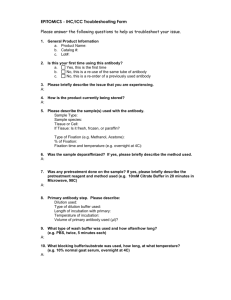

![Anti-PLVAP antibody [MECA-32] ab27853 Product datasheet 3 References Overview](http://s2.studylib.net/store/data/012731941_1-72a4762c09f8db23960912424b5b24e6-300x300.png)

